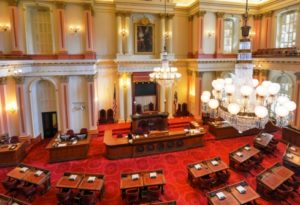News
In simplistic terms, lobbying the state Senate and Assembly floors is similar to lobbying legislative committees, except that the scale is much larger. For example, some committees have as few five members (elected officials), while others have over 20 members. As you would assume, most committees in the 40-member Senate have fewer members sitting on them than do their counterparts in the 80-member Assembly.
News
Santa Clara County Superior Court Judge Stephen Manley refers to defendants in his courtroom as “clients” – an indication of the unusually informal and conversational tenor of the Behavioral Health Court he created more than two decades ago. “It tends to break through a barrier,” Manley said.
News
When preparing to lobby legislative committees, the focus is on legislative staff and then legislators. There are two types of staff for our purposes: committee and member. Committee staff, referred to as committee consultants, are those who work directly for the legislative policy or fiscal committees. Member staff are those who work directly for an Assembly member or senator.
News
California voters have apparently approved spending $5.5 billion more on stem cell research over the next 10 to 15 years and significantly broadening the scope of its state stem cell agency, according to unofficial figures this morning.
News
As has been reported in Capitol Weekly, the early vote has been dominated by Democratic voters. This is in direct contrast to every other election in California history in which Republicans have over-performed in the early returns, leaving Democrats to play catch-up in the late mail and Election Day vote.
News
A pair of Nov. 3 ballot measures seeks to confer voting rights on two wildly disparate groups of Californians — prisoners and teenagers. Prop. 17 would amend the state constitution to restore voting rights to prison inmates who have completed their sentences. Prop. 18, another constitutional amendment, would allow 17-year-olds to vote in primary and special elections if they become 18 by the next general election.
News
Capitol Weekly’s tracking poll of by-mail voters has been running since Oct. 13 and reflects the ballooning numbers of early returns. This electorate, as reported in a prior CA120 article, overwhelmingly leans Democratic, with a significant number of likely Republican voters still expected to turn out on Election Day. As a result, the findings on ballot measures explored in this initial report skew to the left. For experienced poll watchers, this is the opposite of the early exit polling that often skews Republican.
News
A recent dustup with the California Republican Party using unofficial dropboxes as a version of so-called “ballot harvesting” has brought the state’s ballot delivery process under a national spotlight. Much of this controversy can be attributed to the misleading way in which the law has been interpreted, most commonly by people who are trying to conjure up scandal and supposed misdeeds by campaigns that organize such efforts and win.
News
Proposition 22 has ignited the most expensive ballot proposition fight in California history, exemplifying the emerging 21st century battle of traditional employment-vs.-the gig economy. Meanwhile, the Trump administration is poised to weigh in.
News
Over five million California voters – nearly a quarter of the state’s registered electorate — have returned ballots for the General Election, which is less than two weeks away. This milestone, hit yesterday at 13 days until the election, wasn’t achieved in 2016 until the day before the election and exceeds the entire early by-mail vote in 2018.










